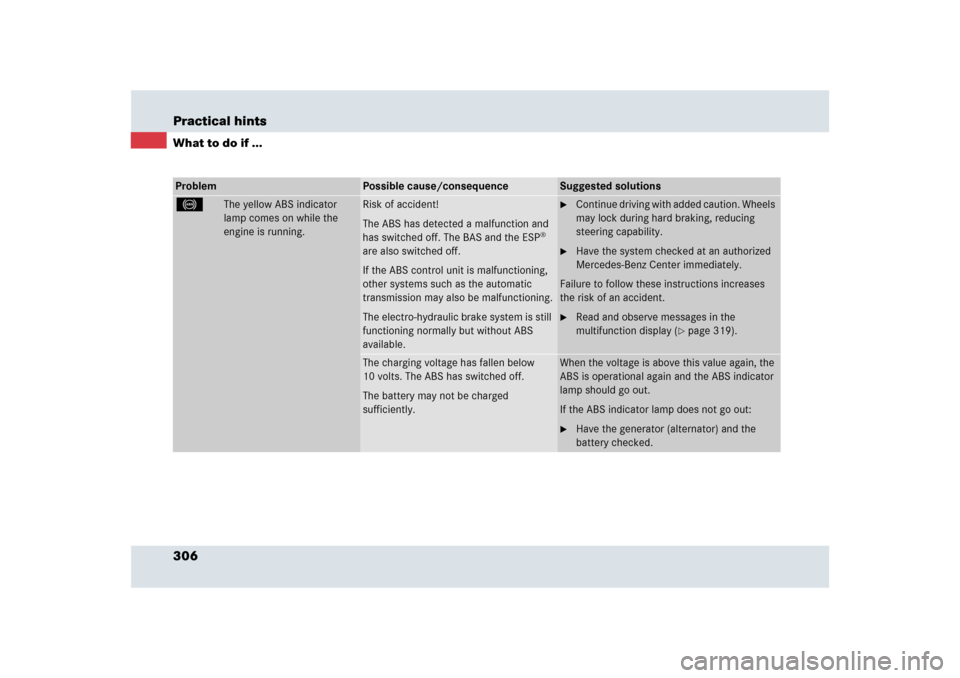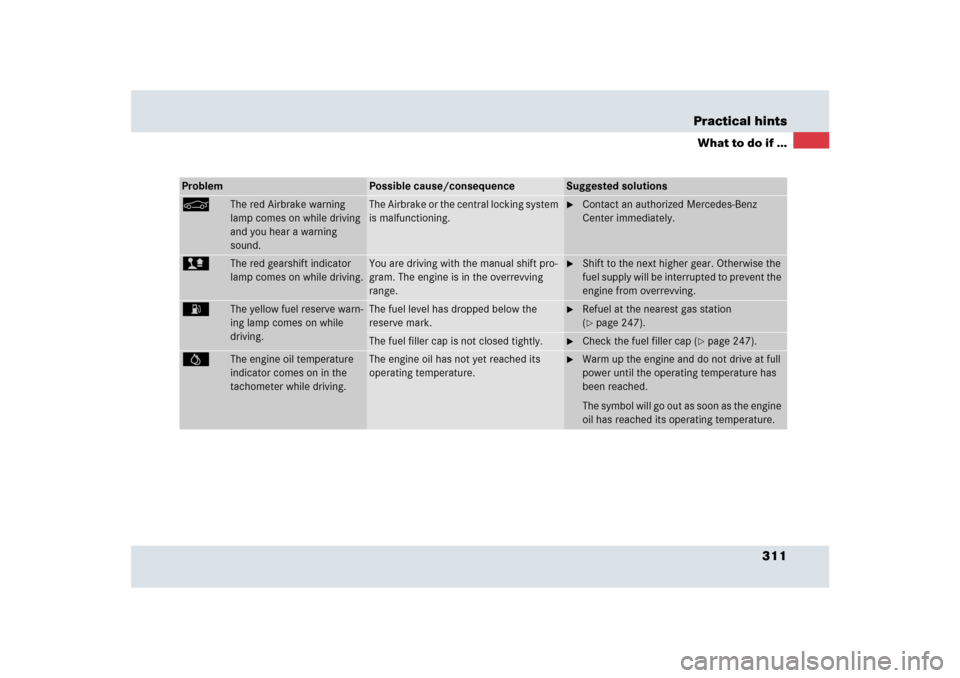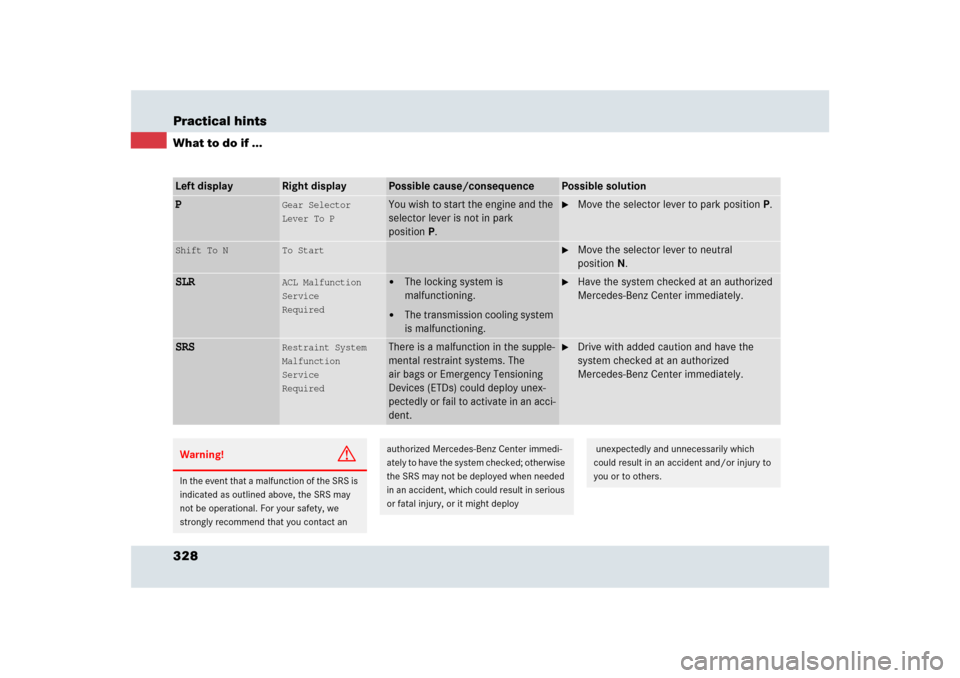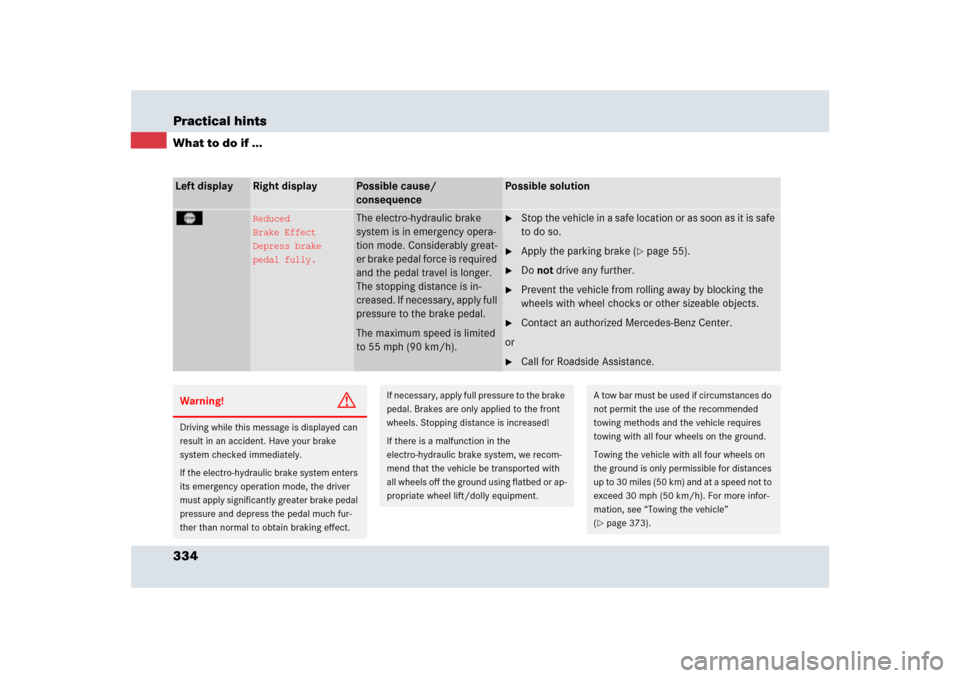Page 302 of 426
Practical hintsWhat to do if ...
Where will I find ...?
Unlocking in an emergency
Replacing SmartKey batteries
Replacing bulbs
Replacing wiper blades
Flat tire
Batteries
Towing the vehicle
Fuses
Page 306 of 426

306 Practical hintsWhat to do if ...Problem
Possible cause/consequence
Suggested solutions
-
The yellow ABS indicator
lamp comes on while the
engine is running.
Risk of accident!
The ABS has detected a malfunction and
has switched off. The BAS and the ESP
®
are also switched off.
If the ABS control unit is malfunctioning,
other systems such as the automatic
transmission may also be malfunctioning.
The electro-hydraulic brake system is still
functioning normally but without ABS
available.
�
Continue driving with added caution. Wheels
may lock during hard braking, reducing
steering capability.
�
Have the system checked at an authorized
Mercedes-Benz Center immediately.
Failure to follow these instructions increases
the risk of an accident.
�
Read and observe messages in the
multifunction display (
�page 319).
The charging voltage has fallen below
10 volts. The ABS has switched off.
The battery may not be charged
sufficiently.
When the voltage is above this value again, the
ABS is operational again and the ABS indicator
lamp should go out.
If the ABS indicator lamp does not go out:�
Have the generator (alternator) and the
battery checked.
Page 311 of 426

311 Practical hints
What to do if ...
Problem
Possible cause/consequence
Suggested solutions
<
The red Airbrake warning
lamp comes on while driving
and you hear a warning
sound.
The Airbrake or the central locking system
is malfunctioning.
�
Contact an authorized Mercedes-Benz
Center immediately.
>
The red gearshift indicator
lamp comes on while driving.
You are driving with the manual shift pro-
gram. The engine is in the overrevving
range.
�
Shift to the next higher gear. Otherwise the
fuel supply will be interrupted to prevent the
engine from overrevving.
A
The yellow fuel reserve warn-
ing lamp comes on while
driving.
The fuel level has dropped below the
reserve mark.
�
Refuel at the nearest gas station
(�page 247).
The fuel filler cap is not closed tightly.
�
Check the fuel filler cap (
�page 247).
=
The engine oil temperature
indicator comes on in the
tachometer while driving.
The engine oil has not yet reached its
operating temperature.
�
Warm up the engine and do not drive at full
power until the operating temperature has
been reached.
The symbol will go out as soon as the engine
oil has reached its operating temperature.
Page 321 of 426
321 Practical hints
What to do if ...
Text messagesLeft display
Right display
Possible cause/consequence
Possible solution
ABS
ABS, ESP
Unavailable
See
Oper. Manual
Risk of accident!
The ABS and ESP
® are not available
due to a malfunction. The BAS is also
deactivated.
The system’s self-diagnosis may not
be completed yet.
The electro-hydraulic brake system
is still functioning normally but with-
out the ABS, the ESP®, and the BAS
available.
�
Drive a short distance with added caution at
a vehicle speed of above 12 mph
(20 km/h).
When the message disappears, the ABS, the
ESP
®, and the BAS are available again.
If the message does not disappear:
�
Continue driving with added caution.
Wheels may lock during hard braking,
reducing steering capability.
�
Have the system checked at an authorized
Mercedes-Benz Center as soon as possible.
Failure to follow these instructions increases
the risk of an accident.
Page 322 of 426

322 Practical hintsWhat to do if ...Left display
Right display
Possible cause/consequence
Possible solution
ABS
ABS, ESP
Inoperative
See
Oper. Manual
Risk of accident!
The ABS and ESP
® have switched off
due to a malfunction.
The BAS is also deactivated.
The electro-hydraulic brake system
is still functioning normally but with-
out the ABS, the ESP
®, and the BAS
available.
�
Continue driving with added caution.
Wheels may lock during hard braking,
reducing steering capability.
�
Have the system checked at an authorized
Mercedes-Benz Center as soon as possible.
Failure to follow these instructions increases
the risk of an accident.
––– MPH(USA only)––– Km/h(Canada only)
Cruise Control
One of the activation conditions for
cruise control has not been fulfilled.
For example, you attempted to set a
speed below 20 mph (30 km/h).
�
Drive faster than 20 mph (30 km/h), if the
situation allows, and set the speed.
(�page 205).
The ESP
® is switched off.
�
Switch on the ESP
® (�page 87).
Exceptions: (
�page 86).
Page 328 of 426

328 Practical hintsWhat to do if ...Left display
Right display
Possible cause/consequence
Possible solution
P
Gear Selector
Lever To P
You wish to start the engine and the
selector lever is not in park
positionP.
�
Move the selector lever to park positionP.
Shift To N
To Start
�
Move the selector lever to neutral
positionN.
SLR
ACL Malfunction
Service
Required
�
The locking system is
malfunctioning.
�
The transmission cooling system
is malfunctioning.
�
Have the system checked at an authorized
Mercedes-Benz Center immediately.
SRS
Restraint System
Malfunction
Service
Required
There is a malfunction in the supple-
mental restraint systems. The
air bags or Emergency Tensioning
Devices (ETDs) could deploy unex-
pectedly or fail to activate in an acci-
dent.
�
Drive with added caution and have the
system checked at an authorized
Mercedes-Benz Center immediately.
Warning!
G
In the event that a malfunction of the SRS is
indicated as outlined above, the SRS may
not be operational. For your safety, we
strongly recommend that you contact an
authorized Mercedes-Benz Center immedi-
ately to have the system checked; otherwise
the SRS may not be deployed when needed
in an accident, which could result in serious
or fatal injury, or it might deploy
unexpectedly and unnecessarily which
could result in an accident and/or injury to
you or to others.
Page 332 of 426
332 Practical hintsWhat to do if ...Symbol messagesLeft display
Right display
Possible cause/
consequence
Possible solution
<
Airbrake
Malfunction
The Airbrake locking mecha-
nism is malfunctioning.
�
Contact an authorized Mercedes-Benz Center
immediately.
#
Battery/Alternator
Stop Car
The battery is malfunctioning.
The electro-hydraulic brake
system requires electrical
energy and therefore has only
limited operation. Considerably
greater brake pedal force is
required and the pedal travel is
longer. The stopping distance is
increased. If necessary, apply
full pressure to the brake pedal.
�
Stop the vehicle as soon as it is safe to do so. Adjust
driving to be consistent with reduced braking
responsiveness.
�
Do not drive any further.
�
Call Roadside Assistance.
�
Contact an authorized Mercedes-Benz Center
immediately.
Page 334 of 426

334 Practical hintsWhat to do if ...Left display
Right display
Possible cause/
consequence
Possible solution
T
Reduced
Brake Effect
Depress brake
pedal fully.
The electro-hydraulic brake
system is in emergency opera-
tion mode. Considerably great-
er brake pedal force is required
and the pedal travel is longer.
The stopping distance is in-
creased. If necessary, apply full
pressure to the brake pedal.
The maximum speed is limited
to 55 mph (90 km/h).
�
Stop the vehicle in a safe location or as soon as it is safe
to do so.
�
Apply the parking brake (
�page 55).
�
Do not drive any further.
�
Prevent the vehicle from rolling away by blocking the
wheels with wheel chocks or other sizeable objects.
�
Contact an authorized Mercedes-Benz Center.
or
�
Call for Roadside Assistance.
Warning!
G
Driving while this message is displayed can
result in an accident. Have your brake
system checked immediately.
If the electro-hydraulic brake system enters
its emergency operation mode, the driver
must apply significantly greater brake pedal
pressure and depress the pedal much fur-
ther than normal to obtain braking effect.
If necessary, apply full pressure to the brake
pedal. Brakes are only applied to the front
wheels. Stopping distance is increased!
If there is a malfunction in the
electro-hydraulic brake system, we recom-
mend that the vehicle be transported with
all wheels off the ground using flatbed or ap-
propriate wheel lift/dolly equipment.
A tow bar must be used if circumstances do
not permit the use of the recommended
towing methods and the vehicle requires
towing with all four wheels on the ground.
Towing the vehicle with all four wheels on
the ground is only permissible for distances
up to 30 miles (50 km) and at a speed not to
exceed 30 mph (50 km/h). For more infor-
mation, see “Towing the vehicle”
(�page 373).